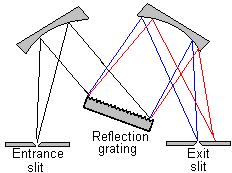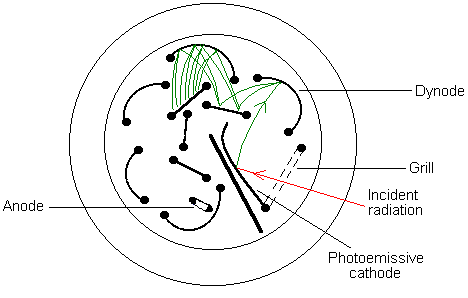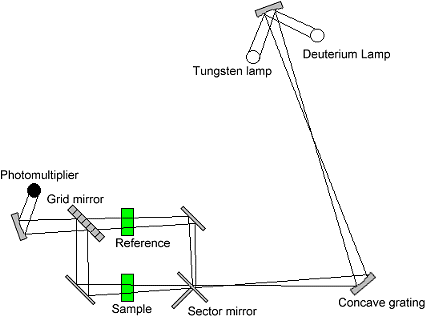


Each of these components will be considered in turn.
It is important that the power of the radiation source does not change abruptly over it's wavelength range.
The electrical excitation of deuterium or hydrogen at low pressure produces a continuous UV spectrum. The mechanism for this involves formation of an excited molecular species, which breaks up to give two atomic species and an ultraviolet photon. This can be shown as;
D2 + electrical energy ® D2* ® D' + D'' + hv
Both deuterium and hydrogen lamps emit radiation in the range 160 - 375 nm. Quartz windows must be used in these lamps, and quartz cuvettes must be used, because glass absorbs radiation of wavelengths less than 350 nm.
The tungsten filament lamp is commonly employed as a source of visible light. This type of lamp is used in the wavelength range of 350 - 2500 nm. The energy emitted by a tungsten filament lamp is proportional to the fourth power of the operating voltage. This means that for the energy output to be stable, the voltage to the lamp must be very stable indeed. Electronic voltage regulators or constant-voltage transformers are used to ensure this stability.
Tungsten/halogen lamps contain a small amount of iodine in a quartz "envelope" which also contains the tungsten filament. The iodine reacts with gaseous tungsten, formed by sublimation, producing the volatile compound WI2. When molecules of WI2 hit the filament they decompose, redepositing tungsten back on the filament. The lifetime of a tungsten/halogen lamp is approximately double that of an ordinary tungsten filament lamp. Tungsten/halogen lamps are very efficient, and their output extends well into the ultra-violet. They are used in many modern spectrophotometers.
Polychromatic radiation (radiation of more than one wavelength) enters the monochromator through the entrance slit. The beam is collimated, and then strikes the dispersing element at an angle. The beam is split into its component wavelengths by the grating or prism. By moving the dispersing element or the exit slit, radiation of only a particular wavelength leaves the monochromator through the exit slit.

The containers for the sample and reference solution must be transparent to the radiation which will pass through them. Quartz or fused silica cuvettes are required for spectroscopy in the UV region. These cells are also transparent in the visible region. Silicate glasses can be used for the manufacture of cuvettes for use between 350 and 2000 nm.
The photomultiplier tube is a commonly used detector in UV-Vis spectroscopy. It consists of a photoemissive cathode (a cathode which emits electrons when struck by photons of radiation), several dynodes (which emit several electrons for each electron striking them) and an anode.
A photon of radiation entering the tube strikes the cathode, causing the emission of several electrons. These electrons are accelerated towards the first dynode (which is 90V more positive than the cathode). The electrons strike the first dynode, causing the emission of several electrons for each incident electron. These electrons are then accelerated towards the second dynode, to produce more electrons which are accelerated towards dynode three and so on. Eventually, the electrons are collected at the anode. By this time, each original photon has produced 106 - 107 electrons. The resulting current is amplified and measured.
Photomultipliers are very sensitive to UV and visible radiation. They have fast response times. Intense light damages photomultipliers; they are limited to measuring low power radiation.

The linear photodiode array is an example of a multichannel photon detector. These detectors are capable of measuring all elements of a beam of dispersed radiation simultaneously.
A linear photodiode array comprises many small silicon photodiodes formed on a single silicon chip. There can be between 64 to 4096 sensor elements on a chip, the most common being 1024 photodiodes. For each diode, there is also a storage capacitor and a switch. The individual diode-capacitor circuits can be sequentially scanned.
In use, the photodiode array is positioned at the focal plane of the monochromator (after the dispersing element) such that the spectrum falls on the diode array. They are useful for recording UV-Vis. absorption spectra of samples that are rapidly passing through a sample flow cell, such as in an HPLC detector.
Charge-Coupled Devices (CCDs) are similar to diode array detectors, but instead of diodes, they consist of an array of photocapacitors.

Do you understand what each component does?
|
|
|

 Biosciences Homepage
Biosciences Homepage
 |